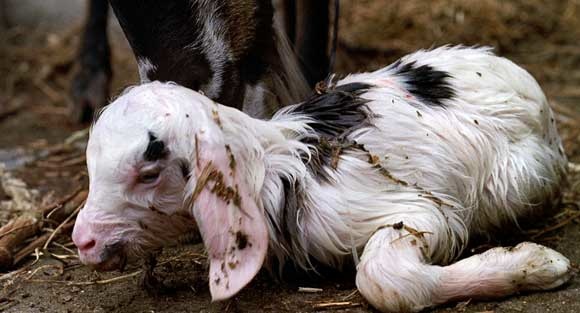[This is the fourth in a series of dispatches relating to the 2010 New York Film Festival.]
Michelangelo Frammartino’s Le Quattro Volte is probably my favorite NYFF film so far. Its commitment to capturing animals on film (and the men who herd them) is reminiscent of last year’s excellent documentary, Sweet Grass. But its scope, which involves a church, an understated examination of the relationship between man and nature, and some intriguing glimpses into a local wood coal industry, is slightly broader and richer. With its soundtrack denuded of intrusive incidental music (the thwacks of manual labor replace the accustomed callow explosions in the rear speakers!), the film is compelling, philosophical, and often quite beautiful in its bucolic splendor. The film shares that Italian cinematographic devotion to capturing slivers of life within a vitrine mise-en-scene – a sort of artsy Where’s Waldo? recalling mid-career Antonioni, but, more importantly, it offers a respectful nudge for audiences to observe the world more closely. Do you notice that artificial bird tied atop a tree? Or the insect crawling across the canvas of an animal’s face (mimicking an earlier shot in which an ant crawls about a dying shepherd’s face)? And what exactly is that smouldering mound at film’s beginning? (No worries! For those bothered by “plotless” movies, there’s a payoff.) Why is dust swept off a church floor later blessed by its caretakers after it is wrapped within ripped magazine sheets? (And is this disposal method altogether sacrosanct?)
Le Quattro Volte is a humble yet moving 88 minute visual poem capturing the cycles of small town life – one that, at times, nearly had me in delightful tears. Frammartino keeps his audience slightly removed from what his human subjects are saying; their Italian words are often just outside earshot – as if to suggest that, because we are mere cinematic observers, these largely unseen toilers have the right to their privacy. Rather interestingly, he has photographed and edited his film as if we’re seeing these striking images from the vantage point of surveillance cameras, and yet the film doesn’t feel invasive of its “subjects.” Certainly, what’s captured could not be confused with scratchy footage. A door opens diagonally, directing us to a table, with its edge mirroring the door’s slant. And on this table, we see a man arranging objects into a bucket. What is he doing? An aging herder climbs a hill with several thin trees shooting up from the ground. With one simple pan to the right, we see not only what a physical burden it is for the man to climb this hill, but how the trees near the top of the hill grow at a less horizontal angle. With one elementary camera move, Frammartino establishes the relationship between man and nature in a matter of seconds. And he implicates the viewer by throwing us under a dark philosophical hood through the black leader edited into the film at strategic intervals.
And there’s one especially amazing long take in which goats sit safely behind a fence lined next to a road, with a protective dog on the other side. A small Catholic parade approaches from the distance, led by men dressed as Centurions. The dog barks at them. The Centurions chase him down the street. The camera pans with the dog. The dog hides in the forest. The parade passes, diminishing in the distance. The dog retreats from his hiding spot and returns to his original position, the camera panning with him. The dog encounters a stray figure from the parade, possibly a boy (we’re not sure, because it’s in the distance), and the boy tries to move past the dog. But the dog barks back, defending his territory. What follows is an amusing interplay, before the boy psychs the dog out with an illusory throw and passes onward. The dog searches about for the stone, and unrustles a vehicle, which proceeds to roll down the adjacent street and into the fence containing the goats. But instead of permitting us to see this collision, the camera moves away.
This moment was – well, for me, at any rate – dazzling cinema. The simple manner in which every behavioral moment led to yet another fascinated me. And keep in mind too that this was merely one poetic piece of the puzzle. And I was further pondering how Frammartino had tracked down such a well-trained dog to make this happen, along with the number of takes it must have required to get this single shot so right.
And yet, for a notable contingent of snobs chattering after the screening, Le Quattro Volte was considered a dud. “I don’t want to see animals falling out of animals,” muttered one such myopic specimen, who then proceeded to describe how she found another film containing a very conventional narrative quite gripping. Well, I certainly don’t want to listen to whiny critics who are interested in having their narrow viewpoints confirmed. But I respect the right of anyone who wishes to live so unadventurously, even if I don’t quite understand why they would be covering a film festival devoted to world voices. Shouldn’t these isolationists be picketing mosques?
For my own part, I was spellbound by the aforementioned animal birth, followed as it was by a mother licking the sticky dew from her fresh baby’s head. How could anyone interested in life not be moved by that? How could anyone not find joy with a goat bleating incongruously atop a table or rowdy men surfing atop a recently felled tree being trawled down a steep slope? Le Quattro Volte offers a wondrous floodgate of such moments. As some guy in Brooklyn seeking fresh perspectives outside his own, Le Quattro Volte was a totally unexpected surprise. This is a movie that reminds us of how inconsequential our actions may be, yet how magical our lives are when seen from afar.
